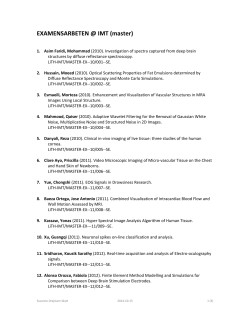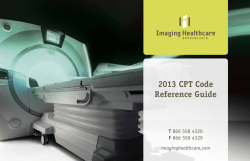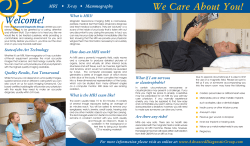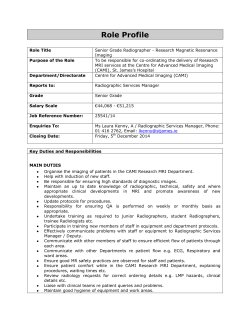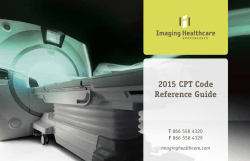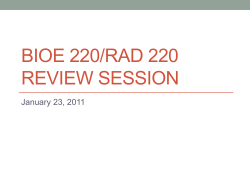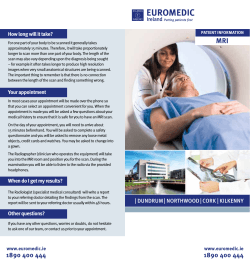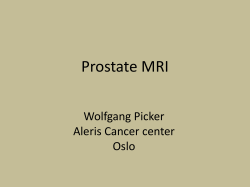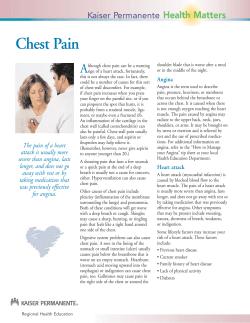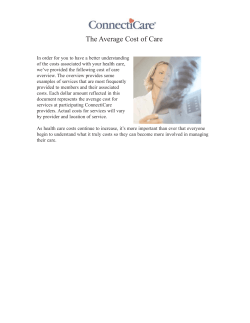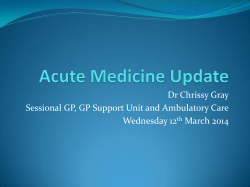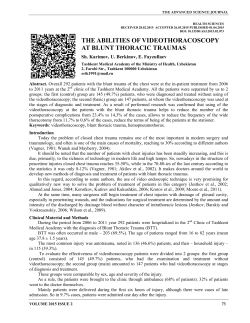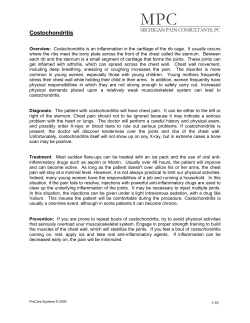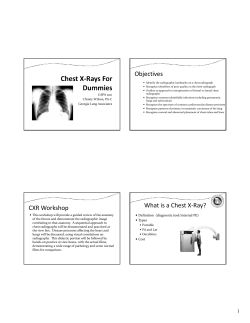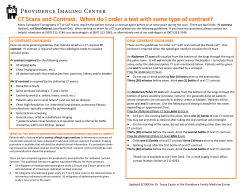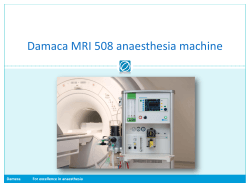
Radiology Frequent MRI/CT Orders - Exams and Indications MRI CT
Radiology Frequent MRI/CT Orders - Exams and Indications MRI CT PLEASE NOTE THE FOLLOWING: CT Chest - Most Frequent Chest CT with IV contrast: 1. To evaluate lung masses or abnormalities seen on chest X-Rays, 2. For the evaluation of suspected primary lung cancer, 3. For the evaluation of a suspected mediastinal mass, or 4. For the evaluation of suspected lung abscess and/or empyema *IF PATIENT HAS HISTORY OF CANCER PLEASE ORDER EXAM WITH AND WITHOUT CONTRAST *IF PATIENT HAS CARDIAC STENTS OR ANEURYSM CLIPS PLEASE REQUEST THAT THE PATIENT BE IMAGED ON A 1.5T SCANNER *IF PATIENT HAS PACEMAKER AND AN MRI IS ABSOLUTELY NECESSARY, PLEASE CONTACT RADIOLOGIST PRIOR TO ORDERING EXAMS MRI Brain Without Contrast 1. Headache, 2. Dizziness, 3. Confusion, or 4. Stroke Chest CT without contrast: 1. For the surveillance of lung nodules, 2. For the initial assessment of a solitary pulmonary nodule, 3. For evaluation of the trachea and central bronchi for masses, pneumothorax, and malacia. MRI Orthopedic All Orthopedic exams are usually Without Contrast unless looking for a tumor or previous cancer or infection With and Without Contrast 1. Tumor, or 2. MS CT Chest - Less Frequent High resolution chest without contrast: 1. To evaluate for interstitial lung disease (ILD) MRI Spine All Spines Without Contrast 1. HNP, 2. Pain, 3. Extremity weakness, 3. Tenderness, or 4. Cauda equina All spines with and without contrast 1. Abscess, 2. Tumor, 3. MS, or 4. Prior spine surgery MRI Abdomen All abdomens have with and without contrast unless the patient is on dialysis 1. Please contact Radiologist for advice Chest CT with IV contrast for PE: 1. Pulmonary angiography for the detection of pulmonary embolism Radiology Reading Room Telephone Numbers Body Chest Mammo Musculoskeletal Neuro General US OB US Nuclear Medicine healthcare.utah.edu/radiology (801) 581-2629 (801) 585-2960 (801) 587-4309 (801) 587-8040 (801) 585-2173 (801) 585-3989 (801) 585-2894 (801) 587-7921 CTA Chest with Contrast - Consult Radiologist First CTA of Chest: 1. CT aortography for the evaluation of the aorta following signifcant blunt chest trauma, 2. Acute aortic syndromes (aortic dissection; acute intramural hematoma; penetrating atherosclerotic ulcer), or 3. aortic aneurysm. Radiology Frequent CT Orders - Exams and Indications CT Body - Most Frequent Abdomen and pelvis with IV and oral contrast: 1. For a general evaluation of all abdominal organs, 2. Evaluate for general abdominal pain, 3. To look for, evaluate, or follow up cancer, 4. To evaluate hernia, or 5. Post trauma for injury to the organs Abdomen and pelvis without contrast: 1. To look for kidney stones, or 2. When there is a contraindication to injection of iodine (Allergies or poor kidney function) CT Neuro - Most Frequent Head CT without contrast: 1. To evaluate for headaches, 2. Post trauma for injuries/bleed, 3. Post op evaluation, or 4. Shunt or other placements Soft tissue neck with IV contrast: 1. To evaluate for neck masses, 2. Any kind of soft tissue pathology in the neck area, or 3. To evaluate for neck or facial swelling and redness CTA of head with IV contrast: 1. To evaluate arteries in brain for possible aneurysms and/or blockage, or 2. To evaluate for stroke CTA of neck with IV contrast: 1. To evaluate arteries in the neck for possible aneurysms and/or blockage, or 2. To evaluate for stroke Sinuses without contrast: 1. To look for or evaluate acute or chronic sinusitis Facial CT without contrast: 1. Trauma to look for facial bones fracture, 2. Post op or pre op for surgery planning, and evaluating hardware Dual phase liver with pelvis with IV and oral contrast: 1. To look for or evaluate liver masses, 2. HCC, 3. Elevated FTEs, or 4. Liver failure C-Spine without contrast: 1. Trauma to look for fracture and injury, 2. Post op to evaluate hardware or interval changes, or 3. To evaluate for DDD or any narrowing T-Bones without contrast: 1. Hearling loss, 2. Ear pain, or 3. Trauma, suspect fracture in temporal region Dual phase pancreas with pelvis with IV and oral contrast: 1. To look for or evaluate pancreatic masses T-Spine without contrast: 1. Trauma to look for fracture and injury, 2. Post op to evaluate hardware or interval changes, or 3. To evaluate for DDD or any narrowing CT Body - Less Frequent CT Enterography with IV and oral contrast: 1. To evaluate Crohn’s disease, or 2. Evaluate small bowel for polyps CTA abdomen and pelvis with IV contrast (CT angiogram): 1. AAA, 2. AAA endograph for leak, 3. To evaluate for ischemic bowel, or 4. To evaluate for abdominal aortic dissection CT Body - Consult Radiologist First Abdomen and pelvis with and without IV contrast: 1. To look for or evaluate renal masses L-Spine without contrast: 1. Trauma to look for fracture and injury, 2. Post op to evaluate hardware or interval changes, or 3. To evaluate for DDD or any narrowing CT Neuro - Less Frequent Head CT with and without IV contrast: 1. Usually done when there is a contraindication to doing an MRI, 2. To evaluate tumors and pathology, or 3. HIV positive patients to evaluate brain CT IVP with IV and oral contrast: 1. Hematuria, or 2. UTI healthcare.utah.edu/radiology CT Neuro - Consult Radiologist First C-Spine with IV contrast: 1. Usually done when MRI is contraindicated, or 2. To evaluate spinal tumors and their effect on bony parts T-Spine with IV contrast: 1. Usually done when MRI is contraindicated, or 2. To evaluate spinal tumors and their effect on bony parts L-Spine with IV contrast: 1. Usually done when MRI is contraindicated, or 2. To evaluate spinal tumors and their effect on bony parts Facial CT with IV contrast: 1.To evaluate for facial swelling and redness.
© Copyright 2025
